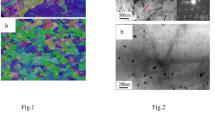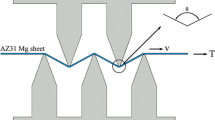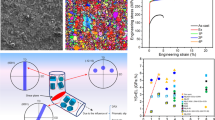Abstract
To develop a new magnesium alloy with excellent formability at room temperature, the effect of Y, Ce, and Gd addition on texture and stretch formability of Mg–1.5Zn alloys was carried out. The result shows that Y, Ce, and Gd addition in Mg–1.5Zn alloys can effectively weaken and modify the basal plane texture, characterized by TD-split texture in which the position of basal is titled from normal direction (ND) toward transverse direction (TD). When Mg–1.5Zn alloy with Gd addition appears low texture intensity and TD-split texture, where the position of basal poles is tilted by about ±35° from ND toward to TD, the largest Erichsen value of 7.0 and the elongation rate reaches 29.1 % in TD direction. However, Y and Ce addition in Mg–1.5Zn alloys promote a large number of second phase particles, which cancel the contribution of the unique basal texture to stretch formability and ductility.





Similar content being viewed by others
References
Friedrich H, Schumann S. Research for a “new age of magnesium” in the automotive industry. J Mater Process Technol. 2001;117(3):276.
Yoshinaga H, Horiuchi R. Deformation mechanisms in magnesium single crystals compressed in the direction parallel to hexagonal axis. Trans JIM. 1963;4:1.
Yoo MH. Slip, twinning, and fracture in hexagonal close-packed metals. Metall Trans A. 1981;12(3):409.
Chino Y, Iwasaki H, Mabuchi M. Stretch formability of AZ31Mg alloy sheets at different testing temperatures. Mater Sci Eng A. 2007;466(1–2):90.
Mukai T, Yamanoi M, Watanabe H, Higashi K. Ductility enhancement in AZ31 magnesium alloy by controlling its grain structure. Scr Mater. 2001;45(1):89.
Watanabe H, Mukai T, Ishikawa K. Effect of temperature of differential speed rolling on room temperature mechanical properties and texture in an AZ31 magnesium alloy. J Mater Process Technol. 2007;182(1–3):644.
Chino Y, Sassa K, Mabuchi M. Enhancement of tensile ductility of magnesium alloy produced by torsion extrusion. Scr Mater. 2008;59(4):399.
Bohlen J, Nurnberg MR, Senn JW, Letzig D, Agnew SR. The texture and anisotropy of magnesium–zinc-rare earth alloy sheets. Acta Mater. 2007;55(6):2101.
Chino Y, Kado M, Mabuchi M. Compressive deformation behavior at room temperature-773K in Mg-0.2 mass%(0.035at%)Ce alloy. Mater Sci Eng. 2008;494(3):343.
Agnew SR, Yoo MH, Tome CN. Application of texture simulation to understanding mechanical behavior of Mg and solid solution alloys containing Li or Y. Acta Mater. 2001;49(20):4277.
Wu D, Chen RS, Tang WN, Han EH. Influence of texture and grain size on the room-temperature ductility and tensile behavior in a Mg–Zn–Gd alloy processed by rolling and forging. Material and Design. 2012;41:306.
Wu D, Chen RS, Han EH. Excellent room-temperature ductility and formability of rolled Mg–Zn–Gd alloy sheets. J Alloy Compd. 2011;509(6):2856.
Yan H, Chen RS, Han EH. Room-temperature ductility and anisotropy of two rolled Mg–Zn–Gd alloys. Mater Sci Eng. 2010;527(15):3317.
Chino Y, Sassa K, Mabuchi M. Texture and stretch formability of a rolled Mg–Zn alloy containing dilute content of Y. Mater Sci Eng A. 2009;513–514:394.
Chino Y, Huang XS, Suzuki K, Sassa K, Mabuchi M. Influence of Zn concentration on stretch formability at room temperature of Mg–Zn–Ce alloy. Mater Sci Eng A. 2010;528(2):566.
Chen Q, Lin J, Shu DY, Hu CK, Zhao ZD, Kang F, Huang SH, Yuan BG. Microstructure development, mechanical properties and formability of Mg–Zn–Y–Zr magnesium alloy. Mater Sci Eng A. 2012;554:129.
McDonald JC. Tensile properties of rolled magnesium alloys—binary alloys with calcium, cerium, gallium, and thorium. Trans AIME. 1941;138:179.
Akhtar A, Teghtsoonian E. Solid solution strengthening of magnesium single crystals—ii the effect of solute on the ease of prismatic slip. Acta Metall. 1969;17(11):1339.
Jeong HT, Ha TK. Texture development in a warm rolled AZ31 magnesium alloy. J Mater Process Technol. 2007;187–188:559.
Acknowledgments
This study was financially supported by the Ministry of Science and Technology “Twelfth Five-Year” Plan for Science & Technology Support (No. 2011BAE22B00).
Author information
Authors and Affiliations
Corresponding author
Rights and permissions
About this article
Cite this article
Cai, ZX., Jiang, HT., Tang, D. et al. Texture and stretch formability of rolled Mg–Zn–RE(Y, Ce, and Gd) alloys at room temperature. Rare Met. 32, 441–447 (2013). https://doi.org/10.1007/s12598-013-0139-5
Received:
Revised:
Accepted:
Published:
Issue Date:
DOI: https://doi.org/10.1007/s12598-013-0139-5




